#antenna mast
Explore tagged Tumblr posts
Text
The Jedi High Council

STAR WARS EPISODE II: Attack of the Clones 00:24:52
This angle and view nearly matches this shot from Episode I. Some differences you can see are the obviously new council members, and a different landscape to the Temple Precinct on Coruscant in the 10 years that have passed.

#Star Wars#Episode II#Attack of the Clones#Coruscant#Galactic City#Temple Precinct#Jedi Temple#Jedi High Council Chamber#Coleman Trebor#Adi Gallia#Oppo Rancisis#Even Piell#Shaak Ti#Saesee Tiin#Anakin Skywalker#Obi-Wan Kenobi#Ki-Adi-Mundi#Yoda#Mace Windu#Plo Koon#Depa Billaba#Eeth Koth#Vurk#Jedi Master#Sembla#Outer Rim#Togruta#Shili#Expansion Region#antenna mast
8 notes
·
View notes
Text



Sometimes you need a mast.
It’s time for a dipole antenna again and I didn’t think an 80’ run to the nearest tree made sense. I’d have more weight in rope than wire.
Previously there was a pool on this property, one I had to demo some 10 years ago now. Well they had this aluminum spindle thingy for the cover and it seemed too good to haul off.
Well now it’s a mast and hopefully serves for many more years.
2 notes
·
View notes
Text
Are EMF’s safe? (come, child, ruin your night)
y’all ready for this? I’m not anti-5G, btw turn your wifi off before bed and maybe stop keepin’ ya phone so close all the time
But like... why, though?
I've had my suspicions about cell towers being hazardous to health for a few years now and felt convinced enough to not bother researchin' it for confirmation. Now that I'm blah blah blah, I decided to actually bother. Since it got kinda heavy, I had to ask myself if I should put in hella more effort creatin' a damn research report of sorts for y'all asses present the info for others like it's a damn PSA. And my conscious won. T~T
But like... what, though?
A base station (aka: cell phone tower) is that shit you see everywhere but never notice. It's usually tall af and has panel antennas on it. It's "used for the transmission and reception of the radio signals between the mobile phones and the network." The problem with 'em is the electromagnetic field (EMF) their equipment can give off... for half a mile. 😐
In short, they've been found to cause health problems. Like cancer. 🤷🏿♂️
Fun fact, panel antennas can be installed on the roof/side of buildings that may be directly across the street from someone's workplace... with the antenna at their elevation. 🤷🏿♀️
Real Quick
For those who don’t trust EMF-Portal, it (sometimes) has links to the study/article. Full-text PDF can be requested directly from the authors on ResearchGate.net’s article for the study. Full-text PDF can (usually) be found online in English and German with the right search.
5 Studies
V/m = volts per meter 7191 cancer deaths were selected according to the above mentioned criterias out of a total of 22,493 cancer deaths. The most significant causes were lung cancer (19.6 %), stomach cancer (14.1 %), prostate cancer (12.6 %), and breast cancer (11.5 %). The mean electric field intensity of the measurements in 2008 was 7.32 V/m, varying from 0.4 to 12.4 V/m. At a distance of up to 100 m [328.08 ft], the absolute number of deaths was 3569, (49.6 % of all deaths), the mortality rate was 43.4 persons per 10,000 [0.43%] and the relative risk was 1.35 in relation to the mortality rate of 32.1 per 10,000 [0.32%] inhabitants of the entire Belo Horizonte municipality [in Minas Gerais, Brazil]. A mortality rate of 34.8 per 10,000 [0.35%] inhabitants was observed for the residents living within 500 m [1,640.42 ft] of the base stations; this rate decreased for residents living farther from the base stations.
—Mortality by neoplasia and cellular telephone base stations in the Belo Horizonte municipality, Minas Gerais state, Brazil; Science of The Total Environment (2011); EMF-Portal
ResearchGate.net’s article


The result of the study [of 967 permanent residents] shows that the proportion of newly developing cancer cases was significantly higher among those [320] patients who had lived during the past ten years at a distance of up to 400 metres [1,312.34 ft] from the cellular transmitter site, which has been in operation since 1993, compared to those patients living further away, and that the patients fell ill on average 8 years earlier. In the years 1999-2004, ie after five years' operation of the transmitting installation, the relative risk of getting cancer had trebled for the residents of the area in the proximity of the installation compared to the inhabitants of Naila[,Germany,] outside the area.
—The Influence of Being Physically Near to a Cell Phone Transmission Mast on the Incidence of Cancer (original title: ‘Einfluss der räumlichen Nähe von Mobilfunksendeanlagen auf die Krebsinzidenz’); Umwelt · Medizin · Gesellschaft (2004); ResearchGate.net
EMF-Portal

9 cancer cases were observed in the first period 2000 - 2004 and 14 cases in the period 2005 - June 2007 among [1,283] residents living within a radius of 400 m [1,312.34 ft] to a mobile phone base station [in Germany (Hennen, suburb of Iserlohn, Westfalia)]. The mean age of disease onset was 59.2 years in the first period and 59.3 years in the second period in comparison to the expected value of 66.4 years evaluated from the Saarland Cancer Registry. The authors concluded, that a statistically significant increase of cancer incidence was observed 5 years after the base station has been started operating.
—[Incidence of cancer adjacent to a mobile telephone basis station in Westfalia] (original title: Krebsinzidenz von Anwohnern im Umkreis einer Mobilfunksendeanlage in Westfalen - Interview-basierte Piloterhebung und Risikoschätzung); Umwelt · Medizin · Gesellschaft (2009); EMF-Portal
Area A: ≤ 350 m / 1148.3 ft from base station Area B: > 350 m / 1148.3 ft from base station Of the 622 people of area A, 8 cases of different kinds of cancer were diagnosed in a period of one year (from July 1997 - June 1998). The cancer incidence rate was 129 cases per 10,000 [1.29%] persons per year in area A compared to 16/10,000 [0.16%] in area B and 31/10,000 [0.31%] in the town of Netanya [in Israel]. Relative cancer rates for females were 10.5 for area A, 0.6 for area B and 1 for Netanya. The authors conclude that the study indicates an association between increased incidence of cancer and living in proximity to a mobile phone base station.
—Increased incidence of cancer near a cell-phone transmitter station; International Journal of Cancer Prevention (2004); EMF-Portal
ResearchGate.net

Took forever to get this damn infographic just right. >.>
A long-term study was conducted in Germany to investigate the influence of a mobile phone base station on neurotransmitters under true-to-life conditions. µW/m² = microWatts per square meter 24 out of 60 participants were exposed to a power density of < 60 µW/m², 20 participants to 60 - 100 µW/m², and 16 participants to more than 100 µW/m² . The values of the stress hormones adrenaline and noradrenaline grew significantly during the first 6 months after starting the GSM base station; the values of the precursor substance dopamine substantially decreased in this time period. The initial condition was not restored even after 1.5 years. Due to the not regulable chronic difficulties of the stress balance, the phenylethylamine levels dropped until the end of the investigation period. The effects show a dose-effect relationship and are situated far under the valid limit values.
—[Modification of clinically important neurotransmitters under the influence of modulated high-frequency fields - A long-term study under true-to-life conditions] (original title: Veränderung klinisch bedeutsamer Neurotransmitter unter dem Einfluss modulierter hochfrequenter Felder - Eine Langzeiterhebung unter lebensnahen Bedingungen); Umwelt · Medizin · Gesellschaft (2011); EMF-Portal
ResearchGate.net’s German article EMF:data page (German)
While I did find 17 different figures for it, I’mma save myself the bother of describin’ dat noise and not include ‘em thanks~.
But what does the FCC say?
FCC.gov’s conclusion seems to be that they’re generally safe for civilian life as long as you don’t get close and aren’t directly in front of the antenna’s trajectory (don’t climb a fuckin’ tower or enter those rooms/buildings). A very “it’s fine” set of conclusions tbh. Hella contrasted by other sources.
Nonetheless… below is the index...
FCC’s RF Safety FAQ Index:
What is "radiofrequency" and microwave radiation?
What is non-ionizing radiation?
How is radiofrequency energy used?
How is radiofrequency radiation measured?
What biological effects can be caused by RF energy?
Can people be exposed to levels of radiofrequency radiation and microwaves that could be harmful?
Can radiofrequency radiation cause cancer?
What research is being done on RF biological effects?
What levels are safe for exposure to RF energy?
Why has the FCC adopted guidelines for RF exposure?
How safe are mobile phones? Can they cause cancer?
How can I obtain the specific absorption rate (SAR) value for my mobile phone?
Do "hands-free" ear pieces for mobile phones reduce exposure to RF emissions? What about mobile phone accessories that claim to shield the head from RF radiation?
Can mobile phones be used safely in hospitals and near medical telemetry equipment?
Are wireless and PCS towers and antennas safe?
Are cellular and other radio towers located near homes or schools safe for residents and students?
Are emissions from radio and television antennas safe?
How safe are radio antennas used for paging and "two-way" communications? What about "push-to-talk" radios such as "walkie-talkies?"
How safe are microwave and satellite antennas?
Are RF emissions from amateur radio stations harmful?
What is the FCC's policy on radiofrequency warning signs? For example, when should signs be posted, where should they be located and what should they say?
Can implanted electronic cardiac pacemakers be affected by nearby RF devices such as microwave ovens or cellular telephones?
Does the FCC regulate exposure to radiation from microwave ovens, television sets and computer monitors?
Does the FCC routinely monitor radiofrequency radiation from antennas?
Does the FCC maintain a database that includes information on the location and technical parameters of all the towers and antennas it regulates?
Which other federal agencies have responsibilities related to potential RF health effects?
Can local and state governmental bodies establish limits for RF exposure?
Where can I obtain more information on potential health effects of radiofrequency energy?
The Government Accountability Office (GAO) prepared a [2012] report of its investigation into safety concerns related to mobile phones. The report concluded that further research is needed to confirm whether mobile phones are completely safe for the user, and the report recommended that the FDA take the lead in monitoring the latest research results.
Professional Opinion...
Safe Distance from Cell Towers…
It is also difficult to predict a safe distance from cell towers. For example, cell towers are designed to transmit most of their radio frequency (RF) energy horizontally. Some areas below the tower may have lower levels than locations farther away that are more in line with the vertical height of the antennas. The exposure from a cell tower will depend on the type of antennas, the number of antennas, how much the antennas are actually being used, the time of day, etc. The distance needed to reduce exposures down to the General Public Precautionary Level of 100 microwatts per meter squared (μW/m²) is often around a quarter of a mile (1320 feet) or more. Due to the uncertainty, on-site testing with a broadband RF test meter is strongly recommended. A German study reported that people living within 400 meters (1312 feet) of cell towers had over 3 times the normal rate for new cancers (City of Naila 2004). In an Israeli study, the relative risk for cancer was about 4 times greater within 350 meters (1148 feet) of the cell tower (Wolf et al. 1997). Based on findings like these, a minimum safety distance of 1/4 mile (1320 feet) might be considered prudent. (...) The suggestions for safety distances in this chart are generally based on Michael Neuert’s [engineer, licensed electrician, and health educator] professional on-site testing of the various EMF sources in the San Francisco Bay Area since 1992.
—What Distance is Safe? By Michael R Neuert, MA, BSME, ©2023
helpful table if you want all that info: What EMF Level is Safe? By Michael R Neuert, MA, BSME, ©2023
i know what i said
Based on the accumulated evidence, we recommend that IARC [the International Agency for Research on Cancer] re-evaluate its 2011 classification of the human carcinogenicity of RFR [radio-frequency radiation], and that WHO [the World Health Organization] complete a systematic review of multiple other health effects such as sperm damage. In the interim, current knowledge provides justification for governments, public health authorities, and physicians/allied health professionals to warn the population that having a cell phone next to the body is harmful, and to support measures to reduce all exposures to RFR.
—Risks to Health and Well-Being From Radio-Frequency Radiation Emitted by Cell Phones and Other Wireless Devices; Front Public Health (2019 Aug 13); NCBI
Lookup (or pull out) your cellphone’s manual and search for the sections on “radio frequency exposure” and “Specific Absorption Rate (SAR) information” to see how close the phone can safely be kept near your body… and that it should be kept away from “the bellies of pregnant women and for teenagers, away from the lower abdomen.” 😐
For an informative giggle, here’s the “Harmful Cell Phones” segment from season 7 of The Colbert Report.
#research#long post#scientific study#telecommunications#telephone base stations#mobile phone base stations#cell towers#cell sites#transmission masts#basis stations#panel antennas#EMF#wifi#cell phones#radiation#cancer#ResearchGate#FCC#RF Safety#radio-frequency radiation#IARC#World Health Organization#physical health#mental health#EMF-Portal#nothin' to see here people#just another day(s) of my life wasted#move along#pretty sure i saw a lone panel antenna relatively low af on a street light pole once
1 note
·
View note
Text
Global Top 7 Companies Accounted for 53% of total Military Submarine Photonics Mast and Antenna market (QYResearch, 2021)
A submarine is a naval platform that can stay underwater for an extended period to carry out missions, both offensive and defensive. It is a complex platform that includes multiple components. As radio waves cannot propagate in water, communication with submarines is difficult. To overcome this issue, submarines are being installed with antennas that can be raised above the water surface level, and employ ordinary radio transmissions for communication.

According to the new market research report “Global Military Submarine Photonics Mast and Antenna Market Report 2023-2029”, published by QYResearch, the global Military Submarine Photonics Mast and Antenna market size is projected to reach USD 0.7 billion by 2029, at a CAGR of 5.7% during the forecast period.
Figure. Global Military Submarine Photonics Mast and Antenna Market Size (US$ Million), 2018-2029

Figure. Global Military Submarine Photonics Mast and Antenna Top 7 Players Ranking and Market Share (Ranking is based on the revenue of 2022, continually updated)

The global key manufacturers of Military Submarine Photonics Mast and Antenna include Thales, L3Harris Technologies, Safran, Hensoldt, Comrod Communication AS, etc. In 2021, the global top four players had a share approximately 53.0% in terms of revenue.
About QYResearch
QYResearch founded in California, USA in 2007.It is a leading global market research and consulting company. With over 16 years’ experience and professional research team in various cities over the world QY Research focuses on management consulting, database and seminar services, IPO consulting, industry chain research and customized research to help our clients in providing non-linear revenue model and make them successful. We are globally recognized for our expansive portfolio of services, good corporate citizenship, and our strong commitment to sustainability. Up to now, we have cooperated with more than 60,000 clients across five continents. Let’s work closely with you and build a bold and better future.
QYResearch is a world-renowned large-scale consulting company. The industry covers various high-tech industry chain market segments, spanning the semiconductor industry chain (semiconductor equipment and parts, semiconductor materials, ICs, Foundry, packaging and testing, discrete devices, sensors, optoelectronic devices), photovoltaic industry chain (equipment, cells, modules, auxiliary material brackets, inverters, power station terminals), new energy automobile industry chain (batteries and materials, auto parts, batteries, motors, electronic control, automotive semiconductors, etc.), communication industry chain (communication system equipment, terminal equipment, electronic components, RF front-end, optical modules, 4G/5G/6G, broadband, IoT, digital economy, AI), advanced materials industry Chain (metal materials, polymer materials, ceramic materials, nano materials, etc.), machinery manufacturing industry chain (CNC machine tools, construction machinery, electrical machinery, 3C automation, industrial robots, lasers, industrial control, drones), food, beverages and pharmaceuticals, medical equipment, agriculture, etc.
0 notes
Text

2.4GHz Fiberglass Antenna With N Male St. Connector
A 2.4GHz #fiberglassantenna refers to an antenna designed to operate in the 2.4 gigahertz (GHz) frequency range. This frequency range is commonly used for various wireless communication applications, including Wi-Fi, Bluetooth, and some remote control systems.
Fiberglass antennas are popular for #outdoor applications due to their durability and resistance to weather conditions. The fiberglass material used in the antenna construction provides protection against environmental factors such as rain, sunlight, and wind.
Know More At - Contact Us - 8889017888 📞 👉Website - https://eteily.com/3-rf-antenna
#telecom#rfantenna#rf#outdoor#antenna#frequency#eteily#connector#omnidirectional#manufacturers#telecomcompany#india#fiberglass
#fiberglass antenna#5.8dbi fiberglass antenna#8dbi fiberglass antenna#permanent fiberglass antenna mast#military surplus fiberglass antenna#lora fiberglass antenna#fiberglass vs aluminum antenna#fiberglass cb antenna#fiberglass antenna boat#fiberglass radio antenna boat#fiberglass marine band antenna#best fiberglass antenna#buy fiberglass antenna#fiberglass cb antenna spring#fiberglass dipole antennas#6 dbi fiberglass lora antenna#dual fiberglass cb antenna#915mhz 6 dbi fiberglass lora antenna#fiberglass pole for antenna
0 notes
Text



My First Astrophotography — Wasserkuppe, Rhoen, Germany (August 2024).
Took a workshop with a fellow photographer to learn how to shoot at night. These are the results. Not exactly breathtaking, but I went out, took the pictures, and here they are—part of the process, I guess.
The radome’s red glow? Not a dramatic edit, just the effect of a nearby antenna mast and its red aviation warning light.
#photographers on tumblr#original photography#night sky#radome#astrophotography#amateur photography#wasserkuppe
83 notes
·
View notes
Text
SPIRIT OF RADIO

AT THE HEIGHT OF THE IPS-N EXPOSÉ, AN UNIDENTIFIED MONARCH PILOT CONDUCTED A SOLO RAID ON CARINA'S PRIMARY COMMUNICATIONS ARRAY. THIS IS THAT STORY.
The spires and antennae of the Yamamoto Communications Array loomed in the near-distance, reaching upwards like lightning rods to heaven from a brutalist concrete base covered in armor plating and turrets. Lux could see guards on patrol in mass-manufactured Drakes and Tortugas, walking along well-trod patrol routes. Prepared trenches and ditches, as well as cleared foliage, spoke to hidden weapons and fortifications; a ground assault would be suicidal.
So, naturally, Lux kept her course and soared directly over the worst of the fortifications, aiming directly for the spires of the Array itself.
Push the envelope. They have no idea anything is going on; they're slow to react. Exploit that.
Her goal was to cut the communications array down, very literally. Half of the communications on Carina ran through the Yamamoto Array, and nearly all of the military communications, with dozens of NHPs working overtime to secure the transmissions against tampering—not to mention it was also the planetary Omninode. Destroying the antennae physically would mean that her tampering would last much longer. Long enough for her to find Jane and get her back to the Assumption of Innocence.
[They've noticed us.] Sacred Symbol's words weren't verbal; more like a buzzing at the back of her mind. [They're confused. Command thinks the outer patrols are hallucinating.]
We'll use that to our advantage, then.
Dawn Always Comes landed on the array's dish with a dancer's grace. Lux sized up the mast in her mind's eye, imagining it in every light, from every direction, in every detail.
[GANDIVA MISSILES ARMED]
Then, she crushed it in her mind. It shattered into a million pieces; a perfect thing, ruined.
[GANDIVA MISSILES RELOADING]
Explosions rippled across the surface armor plating, finding loose screws and worn edges and ripping them apart. The superstructure shuddered and groaned as unexpected stresses began to shear and tear and rip.
[An alarm just went up. They've sent a security team to deal with us.]
As expected.
[GANDIVA MISSILES ARMED]
She took off again and loosed another barrage, this time into one of the cable guideways that kept the antenna steady. The sudden storm of fire wrenched the heavy ring free--with a satisfying twang the cable snapped back, crashing into the antenna and causing an appreciable amount of damage.
[GANDIVA MISSILES ARMED]
[RADAR LOCK WARNING]
Dawn Always Comes danced right and in the next second where she had been was consumed with flame and shot. Magnesium strips simmered, ball bearings scattered, some pinged off her armor; her mech spun around, hovering in the air.
Two Tortugas, armed with their regular war gear. The sigil of IPS-N was emblazoned on their armored pauldrons. Both looked to be factory-fresh.
I don't have time to deal with you.
[SHARANGA MISSILES ARMED]
[JAVELIN ROCKETS ARMED]
Lux closed her eyes again. The Tortuga pilots saw her frame move and braced themselves, preparing to weather a storm of missiles; two solid mountains facing a hurricane.
[SHARANGA MISSILES RELOADING]
[JAVELIN ROCKETS RELOADING]
It never came. Lux opened her eyes and watched as a spiderweb of cracks spread around the two warriors, then with the flick of her finger brought her Javelins down and shattered the ground on which they stood. The two Tortuga pilots would survive--probably, though the fall was long--but they were out of the way for now.
[PROXIMITY WARNING--] She had barely heard the warning before her mech staggered under the weight of a heavy impact and a shot bit into her shoulder. Even with the subjectivity sync dampening the pain, she had to bite her tongue to keep from shouting.
She turned. A shotgun with legs rammed into her chest.
Damn it.
Karateka wavered backwards as the small wrecking ball attempted to ram her again and watched it shoot past her, then turn and rack the slide on its shotgun. The impact of the shell ejecting dented the armor plating of the cable guideway beside it.
[GANDIVA MISSILES ARMED]
The world paused for a moment as both combatants sized one another up. Dawn Always Comes, painted in the dull greys and blacks of raid camouflage, hovered in the air beside the main antenna mast.
[SHARANGA MISSILES ARMED]
Across from her, the Caliban, a sword made purely for the purpose of being a sword, took the stance of a sprinter on the starting block.
[JAVELIN ROCKETS ARMED]
The ejected shell fell to the surface of the dish.
The match began.
Karateka didn't close her eyes, didn't hold her breath, didn't shift at all as she let loose with a barrage of Sharanga Missiles that impacted just short of the charging Caliban. The Caliban returned fire and sent a shot wide of Dawn Always Comes, pinging off the antenna's plating. Lux wove right, narrowly avoiding a ram from her opponent, and landed a solid kick on their backside as they hurtled past. Gravity pressed her into her seat as she fired her thrusters and roared upwards, chasing the Caliban with Gandiva Missiles.
Sacred Symbol, take control. Tlaloc Protocol.
[As you command, fair Lancer. Assuming targeting control. Locking to EM signature... oh my. They haven't done a very good job hiding from my sight.]
Electronic strings reached out as Sacred Symbol turned the micromissiles into marionettes, subtly adjusting their approach angles until they slammed one-two-three-four into the Caliban's arm, breaking past the armor and shattering the bone inside the pilot's arm. Auto-deploying pain-blockers prevented the pilot from collapsing.
[GANDIVA MISSILES ARMED]
Karateka didn't let up. Immediately, a pair of Gandiva missiles streaked away. The Caliban dodged sideways at the last possible moment, missile maneuvering jets scorching marks onto the armor plating. The pilot within the hardsuit-sized mech almost seemed to smile.
[TLALOC PROTOCOL: RETARGETING]
They quickly stopped smiling as the Gandivas slammed into the guideway holding up the antenna mast, causing the structure to shiver, shake, and topple.
Time to go. Karateka gunned the thrusters—back and away, into the sky, watching as the antenna screamed a metallic death rattle as it tore free, delicate electronics shattering. In an instant, the comms array (and with it half the communications on Carina) shorted out, and Karateka was on the move again, leaving a bloodied Caliban and a confused garrison behind.
Her speed climbed, climbed, climbed—100 meters per second, 200 meters per second, 300 meters per second. A tremendous crack sounded as she broke Mach 1, screaming towards the detainment facility she knew the Intern was being kept in.
I'm coming, Jay.

22 notes
·
View notes
Text

The installation ‘I'm fine’ was installed on Kontraktova Square in #Kyiv. It was made from the equipment of telecommunications devices damaged as a result of Russian aggression against #Ukraine. Hromadske reported this, citing the project's authors. The construction is 7 meters long, as tall as a man, and weighs 2.7 tonnes. The letters ‘I'm Fine’ are assembled from parts of base stations and network equipment damaged by #Russian attacks and occupation. This includes shot antennas, masts, broken wires, and chips torn apart by explosions. ‘The damaged systems reflect not only the scale of the destruction but also the efforts to restore communication even where it seemed irretrievably lost. It is also a symbol of hope and new opportunities that arise even in the most difficult times,’ the project authors said in a comment to Hromadske. The project was created by Ukrainian artist Oleksii Say and producer and founder of the Ukrainian Witness media platform Vitalii Deynega. The installation is a continuation of the ‘I'm fine’ project, which was presented this year at the Burning Man festival in the US. Back then, a similar structure was made of shot road signs and other surfaces damaged by Russian aggression. —Detector Media
26 notes
·
View notes
Text
July 10, 2024 Update from the Battleship Texas Foundation
"BATTLESHIP TEXAS UPDATE
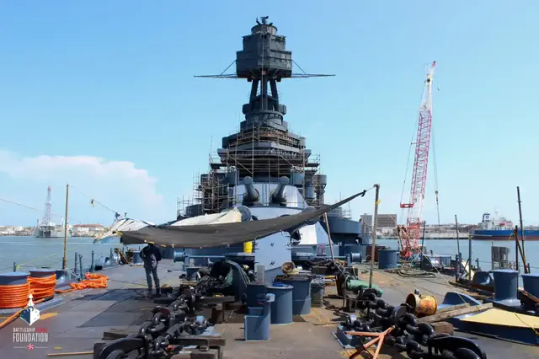
Battleship Texas in Galveston, Texas, undergoing repairs.
The ship is currently moored at Pier D in Gulf Copper Shipyard where it will continue to undergo repairs and preparations to become a museum ship once again.

Navy Blue 5-N has been applied to the forward sections of the ship.
STEEL DECK REPAIRS: The ship’s steel deck has been sandblasted and primed while repairs are ongoing.

Looking down on the bow of Battleship Texas. Steel deck repairs are ongoing while workers prepare the area for a new pine deck.
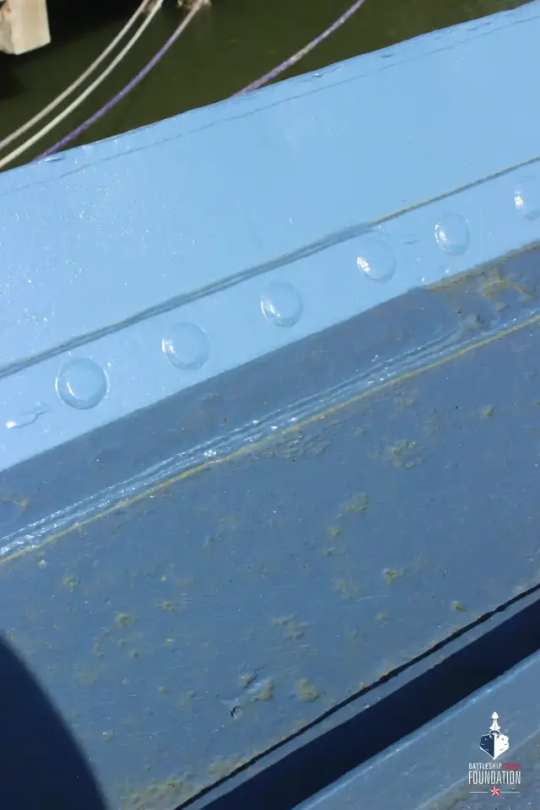
Comparison of Navy Blue 5-N (top) and Deck Blue 20-B (bottom). The ship's pine deck will be painted Deck Blue 20-B.

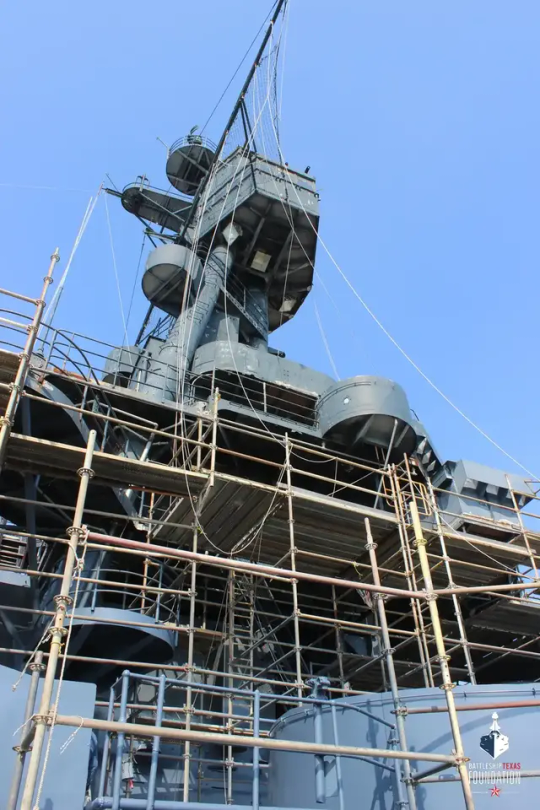
The ship is being painted Navy Blue 5-N.
PINE DECK REPAIRS: Workers have already begun fitting the margin planks to the ship’s deck. These planks are cut to length, fitted to the area of the deck they are going, and primed.


New deck studs (for holding the deck planking down) is being installed on the ship's bow.
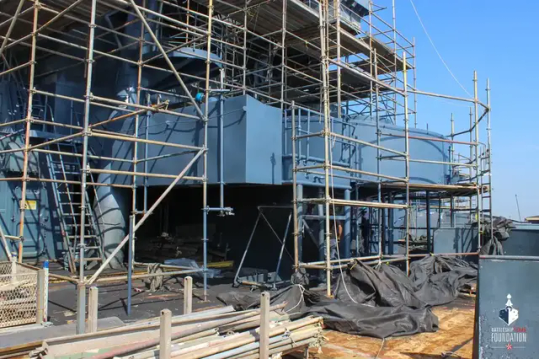

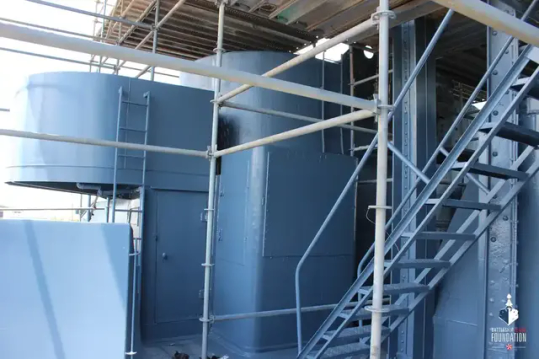
A fresh coat of Navy Blue 5-N has been applied around the ship's superstructure deck and signal bridge.

Pictured is the Signal Records Room.

Pictured is the Navigation Office.
For more history on the deck of Battleship Texas visit: link
MAIN MAST: The ship's main mast continues to be blasted and primed following repairs. The radar top mast, along with its SG and SK, will be reinstalled.

The ship's main mast is being sandblasted and primed before a coat of Navy Blue 5-N is applied.
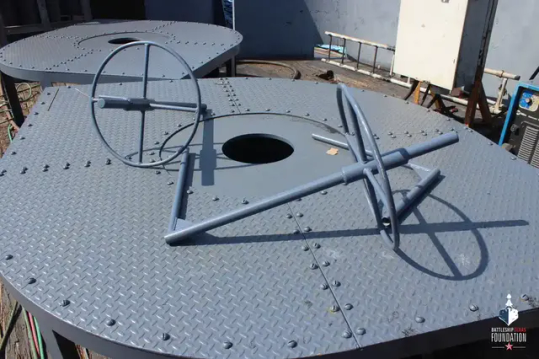
IFF antennas await installation on both the fore and main masts.
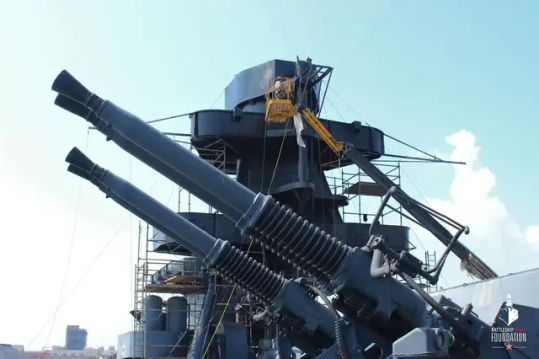
The ship's main mast is being sandblasted and primed before a coat of Navy Blue 5-N is applied.

The ship's main mast is being sandblasted and primed before a coat of Navy Blue 5-N is applied.
BARREL STORAGE TUBES: Storage tubes that once held spare barrels for the ship’s 20mm anti-aircraft guns have been fabricated and reinstalled. Not every tube will be installed at this time, but it is one more step to presenting the ship in its 1945 appearance.
FLOATER NET BASKETS: Several floater net baskets have been added in a few areas aboard. These baskets held nets which were designed to free float if a ship were to sink and provide sailors something to hold on to until they were rescued.
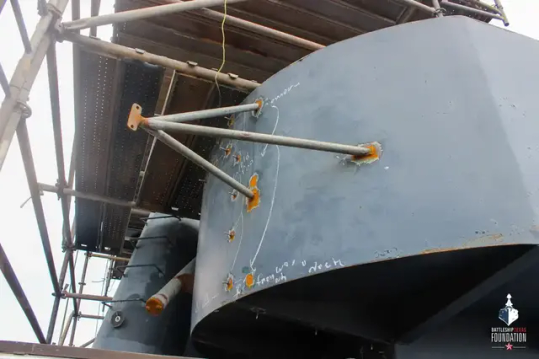
Antenna mounts have been fabricated and installed. Small details like these help bring the ship back into its 1945 appearance.

Ladders are being installed into the correct positions on a clipping room. Small details like these help bring the ship back into its 1945 appearance.
UPCOMING EVENTS:
July 20, 2024 - Join us for a ceremony to welcome the return of the Battleship Texas steel that was flown over France during the 80th Anniversary of D-Day! The Battleship Texas Foundation would like to welcome you to join us on this special occasion. For more information visit: battleshiptexas.org/return-ceremony
FREQUENTLY ASKED QUESTIONS:
WHAT’S NEXT? - Battleship Texas will remain at Gulf Copper Shipyard while the ship’s new home in Galveston, Texas, is prepared. Additional steel work, replacement of the ship’s deck, further restoration, and painting will be done during this time.

Structural repairs are being made to the ship's cranes.

Brackets are installed which will hold the ship's siren and whistle. Both will be made to work again.

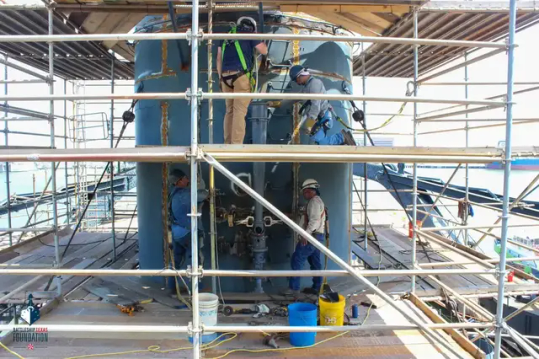
Workers lift parts of the ship's siren for a test fit of the newly installed brackets.

The ship's siren is being fitted to the smokestack.
TOURING? - The Battleship Texas Foundation will be offering touring options while the ship is in the shipyard. Participants will be able to view ongoing work and restoration or learn all about how the ship operated during its service career. An announcement will be made once touring options become available.
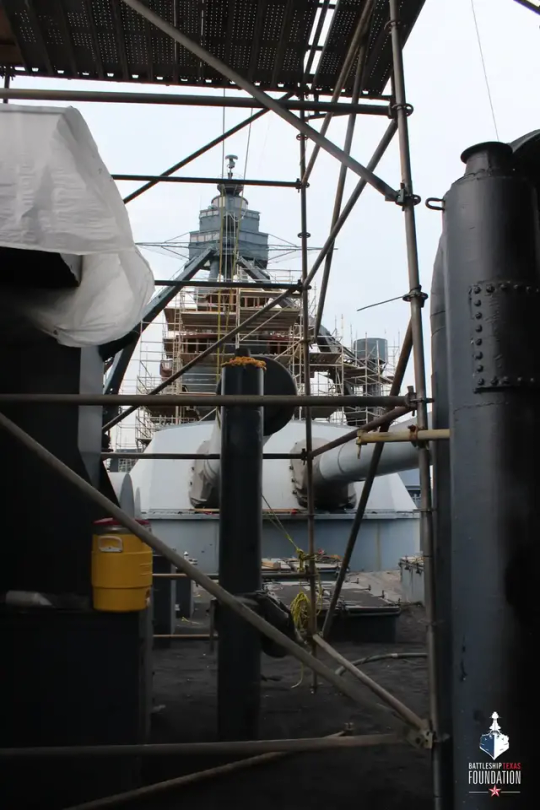
Looking forward from underneath the main mast aboard Battleship Texas.
REOPENING? - There is a lot to be done before the ship is ready for touring at its new home in Galveston, Texas. Reopening is projected to happen in the later half of 2025.
MISSING GUNS? - The ship's anti-aircraft guns are currently undergoing restoration. The guns and gun directors will be replaced once their restoration is complete.
Come on Texas!
To donate to the preservation and operation of Battleship Texas, please visit: battleshiptexas.org/
Support Battleship Texas by making a purchase through the ship's store: https://store.battleshiptexas.org"
Posted on the Battleship Texas Foundation Facebook page: link
#Battleship TEXAS#Battleship Texas Foundation#USS TEXAS (BB-35)#USS TEXAS#New York Class#Dreadnought#Battleship#Warship#Ship#Museum Ship#Update#Galveston#Texas#Repairs#Gulf Copper#Restoration#July#2024#my post
50 notes
·
View notes
Text
Alastor Headcanons: His Body, Anatomy, and Sexuality
His Hellish, cervine body has a light, single-coated coat. He would get molts if Hell had photoperiodism, so if you want an Al that gets floof during the fall and winter, then thank the longer nights and cooler air.
By square inch, deer have more hair follicles than humans, but not Alastor. So even though he’s got visible down on every exposed bit of skin, it’s not particularly dense, making it ineffective at thermoregulating - it doesn’t block enough sun, doesn’t regulate the heat, and doesn’t parse cool air. He’s lucky that he’s a Louisiana-summer-swamp homebody, otherwise Hell’s heat would suck.
If Al ever took a modern health check whilst alive, he’d learn he’s prone to hypotension and high cholesterol. Casual cocaine consumption also messed up his gastrointestinal system, putting him at a high risk of ulcers and hernias. Luckily, he never got one of those ‘cause the surgeries available at the time for ulcers had a whopping 33% mortality rate. He did have repeated potty problems, though, and it was public knowledge that cocaine was the cause. Didn’t stop him.

Heck, I’m not sure if I headcanon Hellaverse bodies as having the same properties of their living counterparts. If they do, then Al’s high meat consumption + cocaine use = nasty shits. He’d be constantly dehydrated, with a horrible acid reflux. And that’s not even taking into account if he drinks alcohol, coffee, or smokes tobacco.
When mortal, Alastor’s body hair was curly, and there was a single very sparse stripe of minimal hair down his sternum that really only betrayed how svelte his figure was, if anything. By adulthood, he had long since accepted that he’d never be the image of masculine fevor.
And yes, the dick has also changed upon death. It didn’t outright turn into an actual deer’s dick, but it now rests inside a pouchy sheath to protect its coat-less flesh. He actually likes that development. Extra coverings. Nature’s own athletic cup.
His asexuality + his age (early forties) means that he has trouble getting it up. If he’s ever getting down and dirty, half the time it’s ¾ mast at most, and it won’t stay hard for long. A lot of his cums are dry, limp ones, and only if he makes the effort at all.
Sinner bodies change based off of what they like about themselves, what they don’t like about themselves, and are largely intended to be ironic caricatures. Alastor’s very aware of the whole ‘deer symbolism’ thing he’s got going on. As the years went on, he also noticed that his chest expands in direct relation to his antlers, and so does his scrotum. Yeah, you heard me.
Basically, I headcanon that Hell sometimes takes a Silent Hill-esque tulpar approach to a sinner’s body. A buck’s rack is symbolic of masculinity, and so is violence. The more bloodthirsty Alastor feels, the more his body morphs its superficial masculine traits. Popular fanon has Al’s father been abusive whilst his mother a supportive and loving figure. In Alastor’s world, violence is masculine.
And by the way, did you know that deer antlers are actually a controlled form of cancer? It begins as cartilage supplied by blood vessels and living tissue, then turns into bone and dies, sitting there as dead weight until the skull decides to sever it. Alastor’s antlers aren’t bone, they’re carbon - the hardest element in mammal bodies, lightly conductive to electricity, and a great transceiver for radio signals. His talons are the same. Sharpened carbon/iron is very deadly.
Alastor’s radio powers have a hard limit on their bandwidth - he can only use the lowest and widest wavelengths. So no atomic powers for him. He can’t even microwave his enemies. Radio waves can transmit very far and deep, but have the lowest effect on atoms. AKA, they’re perfect for relaying sounds and images without irradiating a country.
Now, radio waves need a transceiver to broadcast. Alastor’s entire body is one big transceiver, with his antlers acting as antenna, his body bulk encoding the frequency modulation, and his feet electricity conductors that receive energy from the ground. If none of his body is connected to a power source (like, he’s floating in the air or something), he can still do radio shit, but only AM waves, like real-life radios before electricity.
Now, all that frequency translation takes its toll on the body. Constantly passing low-vibration waves throughout his organs mean a weak heart, varicose veins, brittle bones, lung inflammation, and more. All that, combined with his low BMI and poor diet means he is a sickly man. Tuck into the bedsheets like a dying Victorian child sort of sickly. A doctor from his lifetime would be prescribing him a diet of milk toast and citric acid tablets.
You know he’s letting huge walls down if he so much as coughs whilst in your presence. In public, he’d never be seen rubbing at his aching chest or slouching from his cramping intestines. He’s got an Image to put on, after all.
Don’t coddle his various aches and pains. He knows perfectly well why his body is fucked up, and he doesn’t intend to do anything about it. To him, his wack deer form is riddled with battle scars, proof of his power and hard work.
#hazbin hotel#alastor#hazbin hotel headcanon#hazbin hotel imagines#alastor headcanons#hazbin hotel meta#hazbin hotel headcanons
22 notes
·
View notes
Text
Anakin, Go to the Senate and Ask Chancellor Palpatine to Speak With Her About This Matter

STAR WARS EPISODE II: Attack of the Clones 00:25:35
This shot is nearly the same as a shot in Episode I, but featuring a different color cast over the scene, and Obi-Wan and Anakin as opposed to Qui-Gon and Obi-Wan.

#Star Wars#Episode II#Attack of the Clones#Coruscant#Galactic City#Temple Precinct#Jedi Temple#Jedi High Council Chamber#Obi-Wan Kenobi#Anakin Skywalker#Yoda#Mace Windu#Ki-Adi-Mundi#Cerean cuffs#antenna mast#Plo Koon#door security panel
3 notes
·
View notes
Text

The Apollo LRV
My MOC Lunar Rover, inspired by the real-life “The Apollo Lunar Roving Vehicle”. This is an electric vehicle designed to operate in low lunar gravity. Yes, some people had a chance to drive electric cars long before it became mainstream.
Four lunar rovers were built by Boeing in the early 70’s, one each for Apollos 15, 16, and 17, and one that was used for spare parts after the cancellation of further Apollo missions.




The Lunar Roving Vehicle had a mass of 210 kg and was designed to hold a payload of an additional 490 kg on the lunar surface. A large mesh dish antenna was mounted on a mast on the front center of the rover. Power was provided by two 36-volt silver-zinc potassium hydroxide non-rechargeable batteries with a capacity of 121 amp-hr.
Harrison Schmitt of Apollo 17 said, "....the Lunar Rover proved to be the reliable, safe and flexible lunar exploration vehicle we expected it to be. Without it, the major scientific discoveries would not have been possible; and our current understanding of lunar evolution would not have been possible."

I never got around to taking any kind of artistic photo of this rover (apart from the title photo); it still lies in a container called “Maybe later.”

47 notes
·
View notes
Text
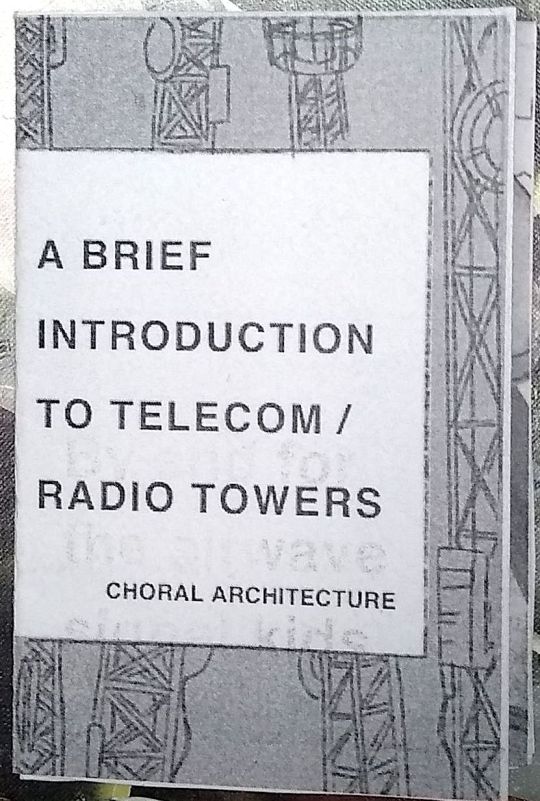
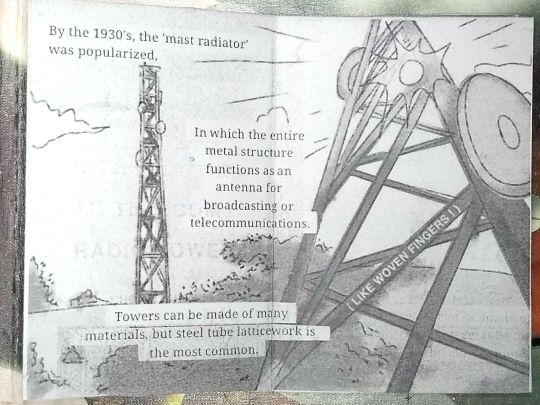
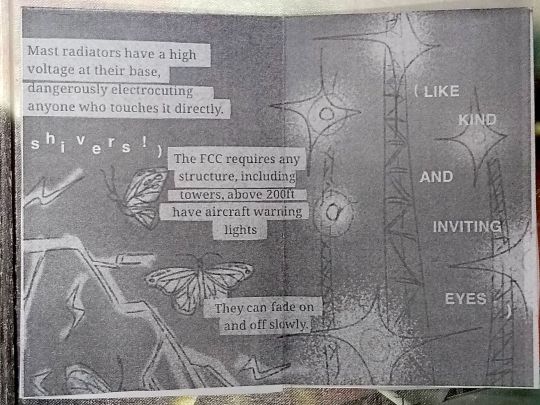

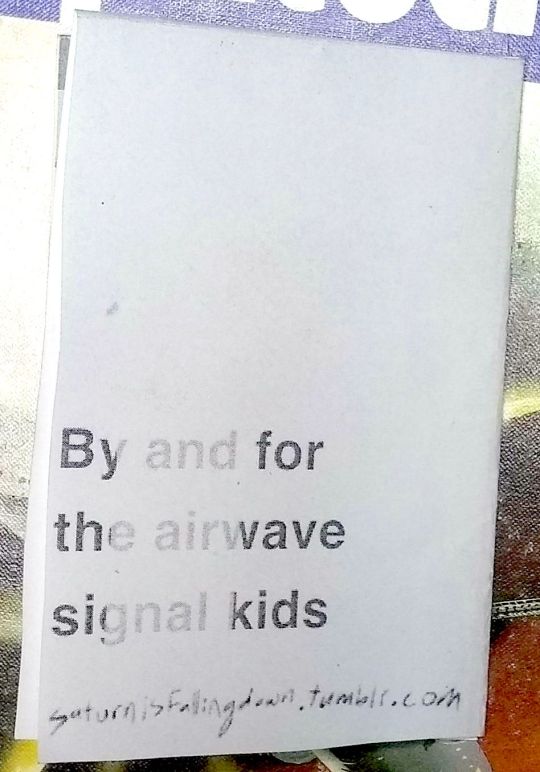
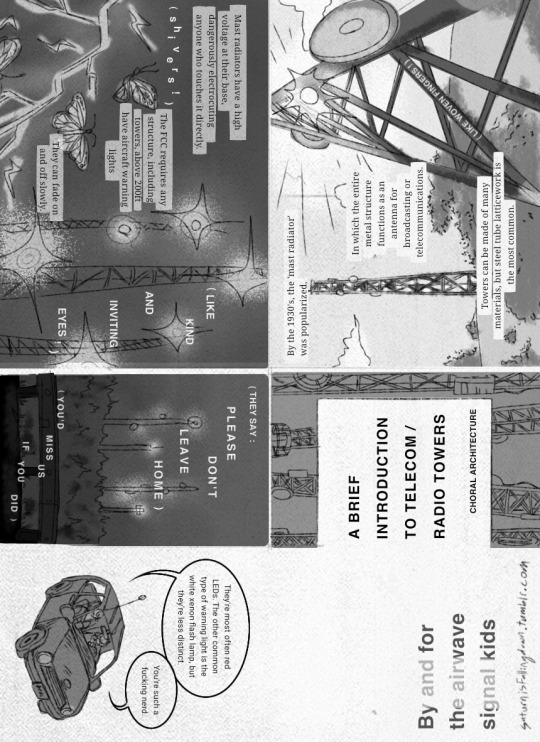
Look at my zine, boy!
[ID: An 8 page printed greyscale zine, with photos posted page by page as well as the full sheet. All pages are illustrations. Cover: 4 drawn radio towers behind the title "A Brief Introduction To Telecom/Radio Towers" with the words "Choral Architecture" in smaller font. Pages 1+2: Two radio towers in a sunny field, one at a distance and one right up by the camera, with the sun shining through it. Text reads "By the 1930's, the mast radiator was popularized. / The entire metal structure functions as an antenna for broadcasting or telecommunications. / Towers can be made of many materials, but steel tube latticework is the most common." Across one of the bars of the tower, white text reads "(Like Woven Fingers!)" Pages 3+4: On the left, a bolt of electricity surrounded by butterflies. On the right, a dark sky with three radio towers lit up with four-pointed-star shaped lights. Text reads "Mast radiators have a high voltage at their base, dangerously electrocuting anyone who touches it directly". White staggered text reads "(shivers!)". The normal text continues "The FCC requires any structure, including towers, above 200ft have aircraft warning lights / they can fade on and off slowly." White text to the side reads "(Like Kind And Inviting Eyes)". Page 5: A view of 4 radio towers at night seen from a road looking out at a forest horizon. White text reads "(They Say: Please Don't Leave Home) (You'd Miss Us If You Did)". Page 6: A car on a white background with two people sat inside. A speech bubble from one reads "They're most often red LEDs. The other common type of warning light is the white xenon flash lamp, but they're less distinct". A bubble from the other reads "You're such a fucking nerd". Back: Text reading "By and for the airwave signal kids". A link to saturnisfallingdown.tumblr.com is written in at the bottom.
End ID]
184 notes
·
View notes
Text
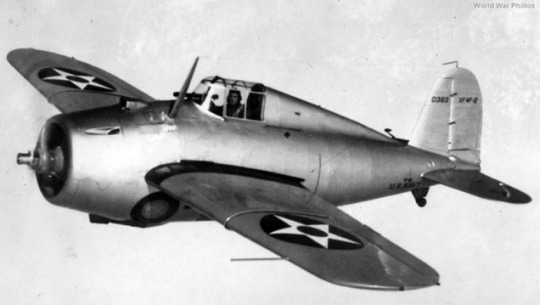
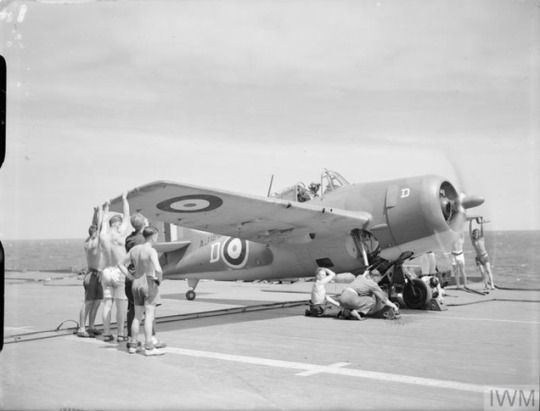


2nd September 1937. First flight of the Grumman XF4F fighter, which would become known as the Wildcat. Its performance was initially inferior to the rival Brewster Buffalo, and the aircraft required an extensive redesign before being put into production. Despite this unpromising beginning, the Wildcat would prove crucial in the early stages of the Pacific war. Though less manoeuvrable than the Japanese Zero, it was well armed, rugged and a capable adversary in the hands of a skilled pilot.
The Wildcat’s first combat sorties were actually flown by the Royal Navy’s Fleet Air Arm. Named Martlet in British use until 1944, the type’s first victory was a Junkers 88 over Scapa Flow on Christmas Day 1940. Martlets went on to serve successfully on the first Royal Navy escort carrier, HMS Audacity, in 1941. They continued in this role until the end of the war, scoring their final victories in Fleet Air Arm service by shooting down four Bf 109s in March 1945.
Wildcats first flew in combat against the Japanese during the attempt to take Wake Island in early December 1941. Four Marine F4Fs mounted a heroic defence, breaking up several air attacks as well as sinking a destroyer and submarine with 100lb bombs before the island finally fell on 23rd December. Wildcats served in all the key early engagements of the Pacific war, including Coral Sea, Midway and the defence of Guadalcanal.
Wildcats quickly established a reputation for toughness, able to absorb far more punishment than their Japanese opponents, and had an impressive kill/loss ratio. Wildcats were credited with destroying over 1,000 Japanese aircraft for 178 aerial losses, 24 to anti-aircraft fire, and 49 to operational causes. One Navy and seven Marine Corps pilots would earn the Medal of Honor in Wildcats.
In early 1943, Wildcat production was taken over by General Motors under the designation FM-1 and later the improved FM-2. Though replaced by the more powerful Hellcat on American fleet carriers during that year, the Wildcat’s small size and light weight made it ideal for use on escort and light carriers. With the addition of folding wings, they were well suited to the limited hangar and deck space available.
As in Royal Naval service, they remained in use until the end of the war. For example, during the battle of Leyte Gulf in October 1944, Wildcats mounted strafing runs against Japanese warships, helping to buy time for their parent escort carriers to escape.
Pictured:
1) First prototype Grumman XF4F-2 in flight. Note the cowling machine guns, forward radio antenna mast and telescopic gunsight, none of which featured on production models.
📷 thisdayinaviation.com
2) Grumman Martlet of 888 Squadron NAS warming up on board HMS Formidable prior to takeoff.
📷 IWM (A 11640)
3) Wrecked Grumman F4F-3 Wildcat fighters of Marine Fighting Squadron 211 (VMF-211), photographed by by the Wake airstrip sometime after the Japanese captured the island on 23rd December 1941. The plane in the foreground, 211-F-11, was flown by Captain Henry T. Elrod during the 11th December attacks that sank the Japanese destroyer Kisaragi. Damaged beyond repair at that time, 211-F-11 was subsequently used as a source of parts to keep other planes operational. Elrod received a posthumous Medal of Honor after leading a beach defence unit during the final Japanese assault.
📷 NHHC 80-G-179006
4) FM-2 Wildcat over the escort carrier USS Santee during the Leyte landings on 20th October. Santee would survive a kamikaze attack and a torpedo hit from a Japanese submarine 5 days later.
📷 NHHC 80-G-287594
@JamieMctrusty via X
#wildcat#martlet#grumman aviation#Goodyear aviation#navy#aircraft#fighter#aviation#us navy#carrier aviation#ww2
13 notes
·
View notes
Text
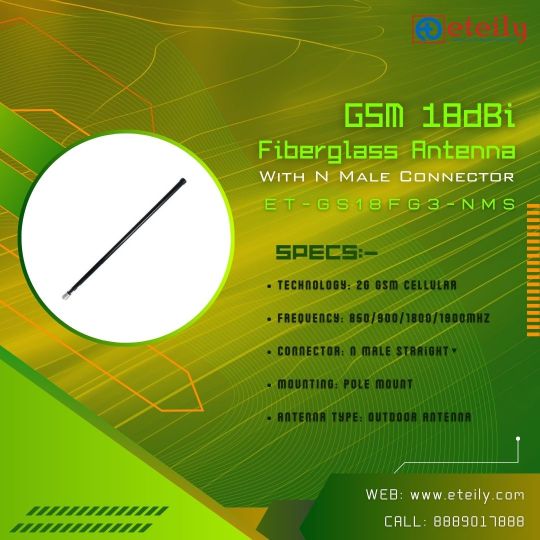
GSM 18dbi Fiberglass Antenna Manufacturers
A fiberglass antenna refers to an antenna element or structure that is made primarily from fiberglass material. Fiberglass is a type of reinforced plastic that is composed of glass fibers embedded in a resin matrix. It's known for its lightweight, durable, and non-conductive properties, which make it suitable for various applications, including antenna construction.
Fiberglass antennas are often used in radio communication, wireless networking, and other applications where an antenna's performance and durability are important. Some key points about fiberglass antennas include:
Non-Conductive: Fiberglass is non-metallic and non-conductive, meaning it doesn't interfere with the electromagnetic signals passing through the antenna. This property can be advantageous in applications where metal antennas might interact with the signals they are transmitting or receiving.
Weather Resistance: Fiberglass is resistant to environmental factors such as rain, sunlight, and temperature variations. This makes fiberglass antennas suitable for outdoor installations where they are exposed to the elements.
Lightweight: Fiberglass is lightweight compared to many other materials used in antenna construction. This can simplify the installation process and reduce the structural load on supporting structures.
Customizable: Fiberglass can be easily molded into different shapes and sizes, allowing for the design of antennas optimized for specific frequency bands and radiation patterns.
Broadband Performance: Depending on the design and construction, fiberglass antennas can be engineered to cover a broad range of frequencies, making them versatile for different communication standards.
Dipole Antennas: One common type of fiberglass antenna is the dipole antenna, which consists of two conductive elements extending in opposite directions from a central feed point. The dipole elements are often made from wire and are supported by a fiberglass structure.
Base Station Antennas: Fiberglass antennas are commonly used in base stations for wireless communication networks, such as cellular networks and Wi-Fi networks. They can provide good signal coverage while being lightweight and unobtrusive.
Radio Amateur (Ham) Antennas: Fiberglass antennas are also popular among amateur radio operators due to their ease of installation, customization, and performance characteristics.
It's important to note that while fiberglass itself doesn't conduct electricity, the conductive elements (such as wires or metal elements) attached to or embedded within the fiberglass structure are responsible for transmitting or receiving the electromagnetic signals. The fiberglass material primarily serves as a supportive and protective structure for these conductive elements.
#fiberglass antenna#5.8dbi fiberglass antenna#8dbi fiberglass antenna#permanent fiberglass antenna mast#military surplus fiberglass antenna#lora fiberglass antenna#fiberglass vs aluminum antenna#fiberglass cb antenna#fiberglass antenna boat#fiberglass radio antenna boat#fiberglass marine band antenna#best fiberglass antenna#buy fiberglass antenna#fiberglass cb antenna spring#fiberglass dipole antennas#6 dbi fiberglass lora antenna#dual fiberglass cb antenna#915mhz 6 dbi fiberglass lora antenna#fiberglass pole for antenna#manufacturer of fiberglass antenna#fiberglass antenna manufacturer#wholesaler of fiber glass antenna#dealer of fiberglass antenna in india#supplier of fiberglass antenna#global supplier of fiberglass antenna#best fiber glass antenna
0 notes
Text


Once I got the radial elements reattached I weaved some electrical tape around them and the main element for added stability before wrapping the main element with some coax-seal. I remounted the antenna back onto the mast and called for a radio check. Not getting a reply, I keyed up a couple of repeaters, so at least I know I'm putting out a signal.
10 notes
·
View notes